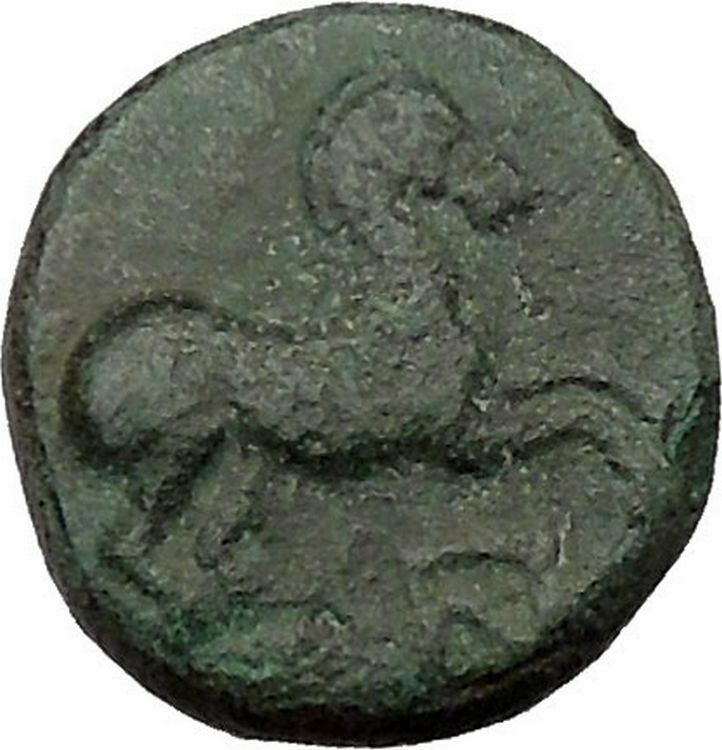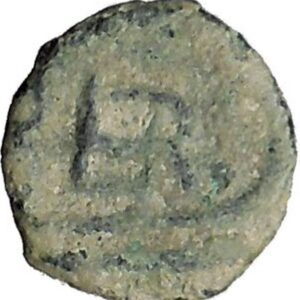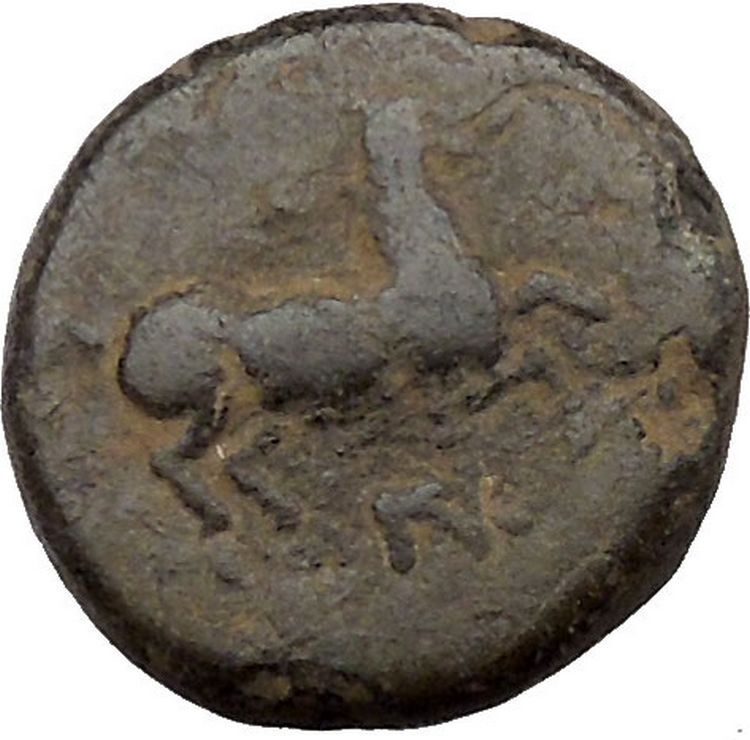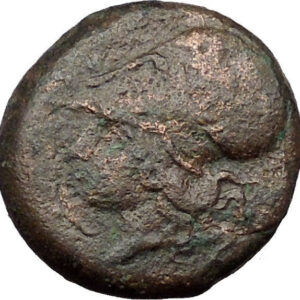|
Greek City of Selge in Psidia
Bronze 12mm (2.98 grams) Struck circa 100-25 B.C.
Reference: Sear 5491; B.M.C. 19.262,47-8
Head of bearded Hercules right, club behind neck.
Winged thunderbolt and bow; Σ – E in field.
The principal city of Pisidia, Selge was situated on the
Eurymedon river about 25 miles north of Aspendos. Its wealth derived from the
fertility of the surrounding country, and its inhabitants who claimed descent
from the Lakedaimonians, were the most warlike in Pisidia.
You are bidding on the exact item pictured,
provided with a Certificate of Authenticity and Lifetime Guarantee of
Authenticity.
The bow and arrow is a projectile
weapon
system (a bow with
arrows
) that predates
recorded history
and is common to most
cultures
.
Archery
is the art, practice, or skill of
applying it.

Description
A bow is a flexible arc which shoots aerodynamic projectiles called
arrows
. A string joins the two ends of the bow
and when the string is drawn back, the ends of the bow are flexed. When the
string is released, the potential energy of the flexed stick is transformed into
the velocity of the arrow.
Archery
is the art or sport of shooting arrows
from bows.
Today, bows and arrows are used primarily for
hunting
and for the sport of
archery
. Though they are still occasionally
used as weapons of war
, the development of
gunpowder
and
muskets
, and the growing size of armies, led to
their replacement in warfare several centuries ago in much of the world.
Someone who makes bows is known as a
bowyer
, and one who makes arrows is a
fletcher
—or in the case of the manufacture of
metal arrow heads, an arrow smith.
History

Scythians
shooting with bows,
Panticapeum
(known today as
Kertch
,
Ukraine
), 4th century BCE.
The bow and arrow is among the oldest composite projectile weapons invented;
only
spear throwers
and
darts
may predate it, having been in use since
30,000 BCE, with the oldest example from 17,500 BCE. However, despite its
ancient provenance, a number of cultures in historical times lacked the bow and
arrow, and in others
oral history
records a time before its
acquisition.
The earliest potential arrow heads date from about 64,000 years ago in the
South African
Sibudu Cave
, though their identification as
arrowheads (as opposed to
spear
or
dart
heads) is uncertain. The first actual bow
fragments are the Stellmoor bows from northern Germany. They were dated to about
8,000 BCE but were destroyed in
Hamburg
during the Second World War, before
carbon 14 dating
was available; their age is
attributed by archaeological association. The oldest bows in one piece are the
elm
Holmegaard bows
from
Denmark
which were dated to 9,000 BCE. High
performance wooden bows are currently made following the Holmegaard design.
The bow and arrow are still used in tribal warfare in
Africa
to this day. An example was documented
in 2009 in Kenya
when the
Kisii-tribe
and
Kalenjin-tribe
clashed resulting in four
deaths.
Construction

Polychrome small-scale model of the archer XI of the west pediment
of the
Temple of Aphaea
, ca. 505–500 BCE.
Parts of the bow
The basic elements of a bow are a pair of curved
elastic
limbs
, traditionally made from
wood, joined by a riser. Both ends of the limbs are connected by a
string known as the
bow string
. By pulling the string backwards the
archer
exerts
compressive force
on the string-facing section,
or
belly
, of the limbs as well as placing the
outer section, or
back
, under
tension
. While the string is held, this stores
the energy later released in putting the arrow to flight.[citation
needed] The force required to hold the string
stationary at full draw is often used to express the power of a bow, and is
known as its draw weight, or weight. Other things being equal, a higher draw
weight means a more powerful bow, which is able to project arrows heavier,
faster, or a greater distance.
The various parts of the bow can be subdivided into further sections. The
topmost limb is known as the upper limb, while the bottom limb is the lower
limb. At the tip of each limb is a nock, which is used to attach the bowstring
to the limbs. The riser is usually divided into the grip, which is held by the
archer, as well as the arrow rest and the bow window. The arrow rest is a small
ledge or extension above the grip which the arrow rests upon while being aimed.
The bow window is that part of the riser above the grip, which contains the
arrow rest.
In bows drawn and held by hand, the maximum draw weight is determined by the
strength of the archer. The maximum distance the string could be displaced and
thus the longest arrow that could be loosed from it, a bow’s draw length, is
determined by the size of the archer.
A composite bow
uses a combination of materials
to create the limbs, allowing the use of materials specialized for the different
functions of a bow limb. The classic composite bow uses wood for lightness and
dimensional stability in the core, horn to store energy in compression, and
sinew
for its ability to store energy in
tension. Such bows, typically Asian, would often use a stiff end on the limb
end, having the effect of a recurve.[16]
In this type of bow, this is known by the Arabic name ‘siyah’.
Modern construction materials for bows include
laminated
wood,
fiberglass
,
metals
, and
carbon fiber
components.
Arrows
An arrow usually consists of a shaft with an arrowhead attached to the front
end, with fletchings and a nock at the other. Modern arrows are usually made
from carbon fibre, aluminum, fiberglass, and wood shafts. Carbon shafts have the
advantage that they do not bend or warp, but they can often be too light weight
to shoot from some bows and are expensive. Aluminum shafts are less expensive
than carbon shafts, but they can bend and warp from use. Wood shafts are the
least expensive option but often will not be identical in weight and size to
each other and break more often than the other types of shafts. Arrow sizes vary
greatly across cultures and range from very short ones that require the use of
special equipment to be shot to ones in use in the
Amazon River
jungles that are 8.5 feet (2.6
metres) long. Most modern arrows are 22 inches (56 cm) to 30 inches (76 cm) in
length.
Arrows come in many types, among which are breasted, bob-tailed, barrelled,
clout, and target. A breasted arrow is thickest at the area right behind the
fletchings, and tapers towards the nock and head. A bob-tailed arrow is thickest
right behind the head, and tapers to the nock. A barrelled arrow is thickest in
the centre of the arrow. Target arrows are those arrows used for target shooting
rather than warfare or hunting, and usually have simple arrowheads.
Arrowheads
The end of the arrow that is designed to hit the target is called the
arrowhead. Usually, these are separate items that are attached to the arrow
shaft by either tangs or sockets. Materials used in the past for arrowheads
include flint, bone, horn, or metal. Most modern arrowheads are made of steel,
but wood and other traditional materials are still used occasionally. A number
of different types of arrowheads are known, with the most common being
bodkins
, broadheads, and piles. Bodkin heads
are simple spikes made of metal of various shapes, designed to pierce armour. A
broadhead arrowhead is usually triangular or leaf-shaped and has a sharpened
edge or edges. Broadheads are commonly used for hunting. A pile arrowhead is a
simple metal cone, either sharpened to a point or somewhat blunt, that is used
mainly for target shooting. A pile head is the same diameter as the arrow shaft
and is usually just fitted over the tip of the arrow. Other heads are known,
including the blunt head, which is flat at the end and is used for hunting small
game or birds, and is designed to not pierce the target nor embed itself in
trees or other objects and make recovery difficult. Another type of arrowhead is
a barbed head, usually used in warfare or hunting.
Bowstrings
Bowstrings may have a nocking point marked on them, which serves to mark
where the arrow is fitted to the bowstring before firing. The area around the
nocking point is usually bound with thread to protect the area around the
nocking point from wear by the archer’s hands. This section is called the
serving. At one end of the bowstring a loop is formed, which is permanent. The
other end of the bowstring also has a loop, but this is not permanently formed
into the bowstring but is constructed by tying a knot into the string to form a
loop. Traditionally this knot is known as the archer’s knot, but is a form of
the timber hitch
. The knot can be adjusted to
lengthen or shorten the bowstring. The adjustable loop is known as the “tail”.
Bowstrings have been constructed of many materials throughout history,
including fibres such as
flax, silk
, and
hemp. Other materials used were animal
guts
, animal
sinews
, and
rawhide
. Modern fibres such as
Dacron
or
Kevlar
are now used in bowstring construction,
as well as steel wires in some compound bows.
Compound bows
have a mechanical system of
pulley cams over which the bowstring is wound.
Types of bows
There is no one accepted system of classification of bows. Some systems
classify bows as either longbows or composite bows. In this system, a longbow is
any bow that is made from one material. Composite bows are made from two or more
layers of different materials. Other classifications divide bows into three
types — simple, backed, and composite. In this scheme, simple bows are made of
one material, backed bows are made of two layers, which could be similar or
different materials. Composite bows are made of three different layers, usually
different materials, but occasionally two of the layers are made from the same
material.
Common types of bow include
-
Recurve bow
: a bow with the tips curving
away from the archer. The curves straighten out as the bow is drawn and the
return of the tip to its curved state after release of the arrow adds extra
velocity to the arrow.
-
Reflex bow
: a bow that curves completely
away from the archer when unstrung. The curves are opposite to the direction
in which the bow flexes while drawn.
- Self bow
: a bow made from one piece of
wood.
- Longbow
: a self bow that is usually quite
long, often over 5 feet (1.5 metres) long. The traditional
English longbow
was usually made of
yew
wood, but other woods are used also.
-
Composite bow
: a bow made of more than one
material
-
Compound
: a bow with mechanical aids to
help with drawing the bowstring. Usually, these aids are pulleys at the tips
of the limbs.
Crossbow
In a crossbow
, the limbs of the bow, called a
prod, are attached at right angles to a crosspiece or
stock
in order to allow for mechanical pulling
and holding of the string. The mechanism that holds the drawn string has a
release or trigger that allows the string to be released. A crossbow shoots a
“bolt” rather than an arrow.
HERCULES – This celebrated
of mythological romance was at first called Alcides, but received the name of
Hercules, or Heracles, from the Pythia of Delphos. Feigned by the poets of
antiquity to have been a son of “the Thunderer,” but born of an earthly mother,
he was exposed, through Juno’s implacable hatred to him as the offspring of
Alemena, to a course of perils, which commenced whilst he was yet in his cradle,
and under each of which he seemed to perish, but as constantly proved
victorious.
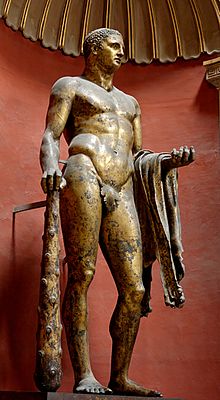
At
length finishing his allotted career with native valor and generosity, though
too frequently the submissive agent of the meanness and injustice of others, he
perished self-devotedly on the funeral pile, which was lighted on Mount Oeta.
Jupiter raised his heroic progeny to the skies; and Hercules was honored by the
pagan world, as the most illustrious of deified mortals. The extraordinary
enterprises cruelly imposed upon, but gloriously achieved, by this famous
demigod, are to be found depicted, not only on Greek coins, but also on the
Roman series both consular and imperial. The first, and one of the most
dangerous, of undertakings, well-known under the name of the twelve labors of
Hercules, was that of killing the huge lion of Nemea; on which account the
intrepid warrior is represented, clothes in the skin of that forest monarch; he
also bears uniformly a massive club, sometimes without any other arms, but at
others with a bow and quiver of arrows. On a denarius of the Antia gens he is
represented walking with trophy and club.
When his head alone is typified, as in Mucia gens, it is covered with the lion’s
spoils, in which distinctive decoration he was imitated by many princes, and
especially by those who claimed descent from him – as for example, the kings of
Macedonia, and the successors of Alexander the Great. Among the Roman emperors
Trajan is the first whose coins exhibit the figure and attributes of Hercules.
Selge (in
Greek/font>
Σελγη) was an important city in
Pisidia
, on
the southern slope of
Mount Taurus
, at the part where the river
Eurymedon River
forces its way through the mountains towards the south.
The town was believed to be a
Greek colony
, for
Strabo
states that it was founded by
Spartans
, but
adds the somewhat unintelligible remark that previously it had been founded by
Calchas
. The
acropolis
of Selge bore the name of Kesbedion.
The district in which the town was situated was extremely fertile, producing
abundance of oil and wine, but the town itself was difficult of access, being
surrounded by precipices and beds of torrents flowing towards the Eurymedon and
Cestrus (today Aksu)
, and requiring bridges to make them passable. In
consequence of its excellent laws and political constitution, Selge rose to the
rank of the most powerful and populous city of Pisidia, and at one time was able
to send an army of 20,000 men into the field. Owing to these circumstances, and
the valour of its inhabitants, for which they were regarded as worthy kinsmen of
the Spartans, the Selgians were never subject to any foreign power, but remained
in the enjoyment of their own freedom and independence. When
Alexander the Great
passed through Pisidia (333 BC), Selge sent an embassy
to him and gained his favour and friendship.
At that time they were at war with
Termessos
.
At the period when
Achaeus
had made himself master of Western Asia, Selge were at war with
Pednelissus
, which was besieged by them; and Achaeus, on the invitation of
Pednelissus, sent a large force against Selge (218 BC). After a long and
vigorous siege, the Selgians, being betrayed and despairing of resisting Achaeus
any longer, sent deputies to sue for peace, which was granted to them on the
following terms: they agreed to pay immediately 400
talents
, to restore the prisoners of Pednelissus, and after a time to pay
300 talents in addition.
We now have for a long time no particulars about the history of Selge; in the
5th century AD Zosimus
calls it indeed a little town, but it was still strong enough to repel a body of
Goths
. It is
strange that
Pliny
does not notice Selge, for we know from its coins that it was still a
flourishing town in the time of
Hadrian
; and
it is also mentioned in
Ptolemy
and
Hierocles
. Independently of wine and oil, the country about Selge was rich
in timber, and a variety of trees, among which the
storax
was much
valued from its yielding a strong perfume. Selge was also celebrated for an
ointment prepared from the iris root.
The remains of the city consist mainly of parts of the encircling wall and of
the acropolis. A few traces have survived of the
gymnasium
, the stoa
,
the stadium
and the basilica
. There are also the outlines of two temples, but the best conserved
monument is the
theater
, restored in the 3rd century AD.
Halfway on the road to Selge from the
Pamphylian
coastal plain,
a well-preserved Roman Bridge
crosses the deep
Eurymedon
valley.
|









